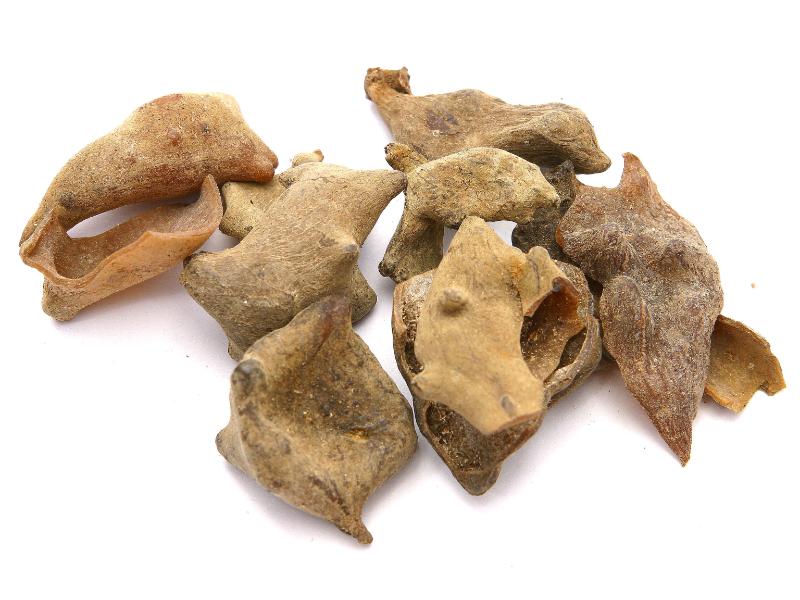Search in medicinals
Galla Chinensis
Sumac gallnut
五倍子 〔五倍子〕 wǔ bèi zǐ

Alternate English names: Chinese gall
Alternate Chinese names: 百虫仓 bǎi chóng cāng; 木附子 mù fù zǐ; 倍子 bèi zǐ
Kingdom: Plant + animal
Origin in PRC Pharmacopoeia: Rhus chinensis Mill.; Rhus potanini Maxim.; Rhus punjabensis Stew. var. sinica (Diels) Rehd. et Wils.; Melaphis chinensis (Bell) Baker. (PRC Pharmacopoeia)
Origin in unofficial sources: Rhus chinensis Mill.* [= R. javanica L.]; Rhus potanini Maxim.*; Rhus punjabensis Stew. var. sinica (Dieds) Rehd. et Wils.*; Melaphis chinensis (Bell) *; Melaphis paitan Tsai et Tang
Use: Medicinal
Category: Exterior-resolving agents
Properties: Sour, astringent; cold.
Channel entry: Lung, kidney, and large intestine channels.
Actions and indications:
- Constrains the lung and downbears fire: Enduring cough due to lung vacuity; lung heat cough with phlegm.
- Astringes the intestines and checks diarrhea: Enduring diarrhea or dysentery.
- Constrains sweating: Spontaneous sweating; night sweating.
- Stanches bleeding: Flooding and spotting; bloody stool and bleeding from hemorrhoids.
- Additional uses: Wǔ bèi zǐ may be used topically to resolve toxins, disperse swelling, stanch bleeding, absorb dampness, and close sores. It is used for toxin swelling of
sore s and boils, ulcerated sores, and prolapse of the rectum or prolapse of the uterus. In these applications, it can be used alone, applied topically as a finely ground powder or decocted as a steam-wash. It can also be used in combination with calcined Bái fán (白矾 Alumen , alum).
Dosage and method: Oral: 3–9 g in decoctions; 1–1.5g per dose in powders or pills. It may also be applied externally, as either a finely ground powder or as steam-wash produced from the decoction.
Warnings: Contraindicated in diarrhea or dysentery when these are due to damp-heat.
Product description: The gallnut created on the Rhus chinesis, Chinese sumac, by the parasite Melaphis chinensis is 8 cm long and 5 cm in diameter. Being rhomboid or ovate in shape with irregular protuberances, it is called the many-horned sumac gall
(jiǎo bèi). The exterior is a yellowish or grayish brown with gray hairs. The skin is 1–2 cm thick, is hard and easily broken into pieces. The fracture appears horny and the inside is hollow, containing the dead body of the insect and a wax-like substance.
Quality: Unbroken thick-skinned gallnuts are the best.
Production area: Sìchuān, Guìzhōu, Guǎngdōng.
Back to search result Previous Next